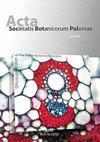跨叶毛茛(毛茛科)是欧洲第三纪植物群的异四倍体遗迹——分子系统发育证据
IF 0.8
4区 生物学
Q3 PLANT SCIENCES
引用次数: 4
摘要
鳗鲡属肝科主要由四倍体(2n = 28)种组成,分布于欧亚大陆。核学证据证明了本节多倍体种的杂交起源。transsilvanica是这个物种群的一个成员,明显的分布仅限于喀尔巴阡山脉东部。根据基因组大小和细胞类型,transsilvanica的父系亲本被描述为anlosa, H. falconeri剖面中唯一的二倍体物种。母种被假设为H. nobilis,一种全裂叶的欧洲种,分布范围更广。尽管特西瓦尼人的杂交起源在核学上得到了很好的证明,但杂交的时间却从未被研究过。利用核基因组和质体基因组序列,重建了transsilvanica及其亲本种的系统发育关系和分化时间。nrITS和质体序列的基因树拓扑结构不一致,证实了亲本种的身份。此外,亲本种的两个基因拷贝都可以鉴定出低拷贝核基因MLH1。使用贝叶斯系统发育方法进行的分化年代分析有力地支持了特兰西瓦尼人在喀尔巴阡山脉东南部长期生存的观点,因为这种杂交物种和亲本物种最近的共同祖先不迟于更新世初期(约300万年前)存在。这些结果不仅突出了喀尔巴阡山脉东南部在第四纪冰期的生物地理学重要性,而且还强调了第三系可能在中欧的隐蔽避难所中幸存下来。本文章由计算机程序翻译,如有差异,请以英文原文为准。
Hepatica transsilvanica Fuss (Ranunculaceae) is an Allotetraploid Relict of the Tertiary Flora in Europe – Molecular Phylogenetic Evidence
The Hepatica section Angulosa consists of mainly tetraploid (2n = 28) species that are distributed disjunctly throughout Eurasia. Karyological evidence proves the hybrid origin of the polyploid species of this section. Hepatica transsilvanica is a member of this species group with a conspicuous distribution restricted to the Eastern Carpathians. Based on genome size and cytotypes, the paternal parent of H. transsilvanica is described to be the only diploid species in section Angulosa, H. falconeri. The maternal species is hypothesized to be H. nobilis, a European species with entirely lobed leaves and a wider distribution area. Although the hybrid origin of H. transsilvanica is well documented by karyological evidence, the time of hybridization has never been studied. By using sequences of both the nuclear and plastid genome, we reconstructed the phylogenetic relationships and divergence times of H. transsilvanica and its parental species. The identity of the parental species is corroborated by discordant gene tree topologies of the nrITS and plastid sequences. Moreover, both gene copies of the parental species could be identified with the low-copy nuclear gene, MLH1. Divergence dating analysis using Bayesian phylogenetic methods strongly supported the long-term survival of H. transsilvanica in the Southeastern Carpathians, as the most recent common ancestor of the hybrid and parent species existed not later than the beginning of the Pleistocene, ca. 3 million years ago. These results not only highlight the biogeographic importance of the Southeastern Carpathians in the Quaternary glaciation periods, but also emphasize that Tertiary lineages could have survived in a Central European cryptic refugium.
求助全文
通过发布文献求助,成功后即可免费获取论文全文。
去求助
来源期刊
CiteScore
2.00
自引率
10.00%
发文量
18
审稿时长
1 months
期刊介绍:
The journal has been published since 1923 and offers Open Access publication of original research papers, short communications, and reviews in all areas of plant science, including evolution, ecology, genetics, plant structure and development, physiology and biochemistry.

 求助内容:
求助内容: 应助结果提醒方式:
应助结果提醒方式:


